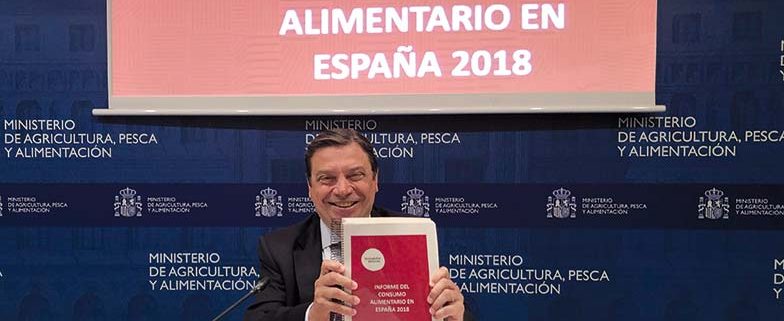The food consumption of Spain increases in 2018
The Minister of Agriculture, Fisheries and Food Act, Luis Planas, presented this Monday, at the headquarters of the Ministry, the data of the Report on Food Consumption in Spain 2018, which gives us an overview of the eating behavior of people residents in our country, both inside and outside the home. Therefore, the consumption made by tourists or that made in institutions and collectives are not collected. As a novelty, this year’s report delves into the sociodemographic aspects of consumption.
In the presentation, Planas stressed that Spanish food is the product of the good work of our agriculture, livestock, forestry and fishing, transformed by industry and distributed to the final consumer through a wide network of purchasing channels. For the minister, “food says a lot and very good from Spain”.
As detailed, the total expenditure on food in 2018 amounted to 103,077.41 million euros, which has been an increase of 0.5% over 2017, maintaining the growing trend of recent years. Of these, 66.5% was destined to domestic consumption and 33.5% (34.539 M €) to consumption outside the home.
In terms of volume, total consumption in Spain reached the figure of 33,464.38 million kg / l, of which 86.1% was consumed at home and 13.9% outside the home. On average, each Spanish ingested around 767.87 kg / l. of food and beverages, and an expense of about 2,526.28 euros. Both consumption and per capita spending was higher within the household than outside.
Consumption in Spanish homes
Total expenditure within
Spanish households amounted to 68,538.1 million euros, which is 1.6% more than in 2017. This increase is due to the increase in the average price (1.8%), since the volume Total acquired remained stable (-0.2%).
The minister has clarified that it is not possible to generate a higher consumption when in terms of population there is no sustained or associated population growth. He also pointed out that to understand the evolution of consumption, it is necessary to analyze aspects related to the number of households in Spain and their composition. Thus, the stagnation of the population, the smaller size of families or the age of its components are conditioning consumption, which is experiencing sustained growth.
In this context of stable consumption, fresh products represent a consumed volume of 39.5%, and a value of 42.9%. The average price of fresh produce, higher than the average food, makes the household allocate a budget similar to last year, although in volume buy less.
The products that suppose a greater volume of consumption are the fruit, vegetables, fresh potatoes, milk and dairy products. Together they represent more than 50% of the kilos consumed in Spanish homes. In value, Spaniards spend more on meat and fish, 33.6% of the budget for food at home.
It is clear from the report that Spaniards tend towards ready-to-eat products (salads of the IV range, prepared dishes or coffee capsules), and reduce the intake of sugars and proteins of animal origin. The consumption of olive oil also acquires a special prominence, with increases of 9.2% in virgin oil volume and 7.2% in extra virgin olive oil.
In light of these data, the minister has indicated that Spaniards in general take care of their food and are willing to spend more on products that offer added value, such as extra virgin olive oil or chocolates with higher cocoa content. that households with children are those that concentrate the highest proportion of consumption in relation to their population weight, together with adult couples without children, and retirees. For their part, the homes of young people consume less at home.
Likewise, the communities with the highest consumption per capita in the home are the Balearic Islands, Catalonia, Canary Islands, Galicia, Valencian Community, Murcia, Castilla y León, Aragón, Castilla-La Mancha and País Vasco, all above the average national. The highest per capita expenditure occurs in the Basque Country along with Catalonia, followed by Galicia. With regard to food purchasing establishments, the supermarket is the channel preferred by consumers, assuming half of the total sales volume. In fresh food, the super and specialty stores are the channels with the greatest share.
Food outside the home
On the other hand, spending on food and beverages outside the home amounted to 34,593.32 million euros, with a consumed volume of 4,637.4 million kg / l. Consumption outside the home is the driver of total food consumption, with an increase in volume of 3.5%.
In volume, outside the home, more beverages are consumed (69%) than food (31%), while the proportion is invested in terms of value (40% in beverages and 60% in food) mainly due to the effect of the price total average and the type of product consumed. On average, each Spanish ingested around 138.18 kg / l. and spent about 1,029.15 euros.
The minister has detailed that per capita consumption outside the home increases with age. Thus, the elderly (aged 60 to 75) are the ones who consume the most outside the home, while young people under 34 are the ones who consume the least. The times of greatest consumption outside the home are meals and dinners, with greater presence of food and, therefore, volume consumed. From the data it is observed that Spaniards prefer to consume in company, either with the family (30.7%), friends (27.1%) or partner (14.6%), the celebration being the main reason for consumption (27.4%).
By type of products, outside the home, the consumption of vegetables, meat, bread, fish and seafood stands out, while fruits do not have as much weight in the extradomestic consumption. As for drinks, beer and water, they concentrate about 55% of drinks outside the home.
Habits and consumer trends
Finally, Planas has offered details of the habits and trends of the Spanish consumer. Thus, the main meals of the day present stability, related to the good evolution of meals and dinners away from home.
It is also evident that Spaniards are heading towards the simplification of the menu at meals and dinners, where versatility and convenience are the key to consumption. Specifically, Spaniards consume more single dish and less complete menu, and the plate to share or accompany is increasingly present. The green salad is the most present dish in the menu of the homes, where the tomato salad gains presence.
The simplification also affects cooking, since households opt for those quicker and healthier preparation methods (griddle, no cooking / cold and boiling / steam).









